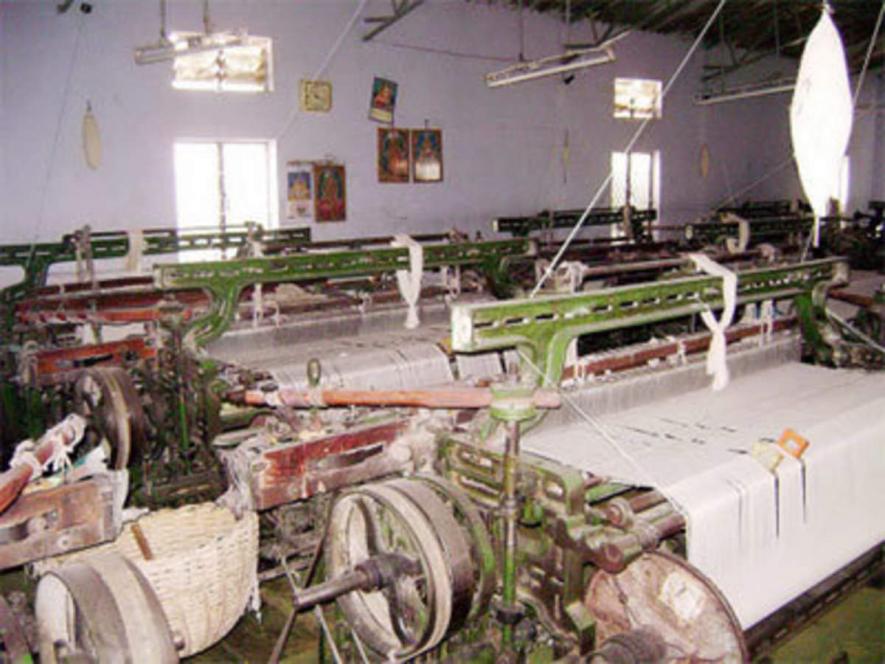Power Tariff Hike: UP Powerloom Weavers Plan Indefinite Strike From Sept 1

Representational Image. Image Courtesy: The Economic Times
Lucknow: Powerloom weavers across Uttar Pradesh are up in arms against the sudden rise in power tariffs by the state electricity board which, they claim, has increased overheads and may lead to complete closure of the textile weaving industry, including the famous Banarasi sarees.
Distressed by the Adityanath-led Bharatiya Janata Party government’s “neglect”, the weavers, under the banner of Varanasi Handloom Weavers Association, have decided to switch off their looms for an indefinite period from September 1.
More than one lakh shops and powerloom weavers in the state are expected to join the strike call given by association, which claimed that the condition of weavers in Varanasi – the parliamentary constituency of Prime Minister Narendra Modi, was grim.
Weavers were once the pride of Varanasi, and were already struggling due to various economic reasons, but their plight has become worse after the power tariff hike and due to COVID-19-induced lockdown since March. There have been reports of how some weavers had been compelled to pawn jewellery, houses and even their powerlooms for survival.
Iftekhar Ahmed Ansari, president of the Uttar Pradesh Weavers' Association, said the electricity tariff rate for powerloom weavers had been increased significantly. Ever since the UP government did away with the flat tariff rate for weavers, lakhs them were badly hit. Ansari alleged that the electricity department was harassing weavers by asking to pay arbitrary bills.
"Since 2006, the electricity bill was being paid at flat rates. We used to pay Rs 71.5/month for a powerloom. Today, this rate has increased manifold. Now the bill for each powerloom comes to around Rs 1,500," Ansari told NewsClick, adding that weavers were unable to pay this amount due to mounting financial difficulties following economic slowdown and the pandemic-induced lockdown.
This is why a meeting of the steering committee of the Uttar Pradesh Weavers' Association decided that the weavers will shut down their powerlooms for an indefinite period from September 1.
Sharing the ordeal of weavers, Ansari further said: "Even after this (the indefinite strike), if the government does not reduce the electricity rates, weavers of Varanasi would cut off their electricity connections forever”.
The association president said that a weavers’ delegation had also met Chief Minister Yogi Adityanath in this regard and were assured that they would be charged at the old rate. But this has proved to be nothing but mere lip service.
Accusing the Yogi government for changing the tariff scheme to get rid of the “increasing burden of subsidy” and “prevent misuse”, the association said powerloom weavers will now be exempted from the flat rate to a certain number of power units every month. Small powerlooms (up to 0.5 horsepower) will be given a
rebate of Rs 3.5 per unit to 120 units and large powerlooms (up to one horsepower) to the extent of 240 units every month.
Meanwhile, the assistant director (handlooms) Nitesh Dhawan, has admitted that the new power tariff plan had left the textile industry worried. “We have written a letter to the state government, with a request to sympathetically look at the weavers”, he told NewsClick.
Weavers Demand Power Subsidy
The biggest demand of powerloom weavers in Varanasi is subsidy, which has been changed since January this year. In fact, in December last year, the Yogi Adityanath cabinet had decided that powerloom weavers would get a bill after meter reading every month instead of flat rate, and only a certain number of bills would be exempted.
Akhtar Nabi, a weaver who lives in Nakki Ghat of Varanasi, said: “We used to pay Rs 150 a month till now for electricity. Now this will come to between Rs 2,500 to Rs 3,000. If we pay so much, what will be left for labourers?”
Nabi said work started slowly returning to a 'new normal' after months of standstill, when government people arrived to collect outstanding bills.
Adil Zubair, secretary of Bunkar Mahasabha, said, electricity on fixed rates under the powerloom scheme should be restored immediately.
"Ever since the subsidy was withdrawn by the state government in January last year, most of the weavers have been forced to look at another business," he said, adding that if these conditions continue, over 50% weavers will have to sell their machines and leave the profession.
"The government did not help us in the lockdown. The powerloom employs skilled labour. A lot of foreign exchange is earned from it. Tourism gets a boost. The government is getting Rs 12,000 crore from GST, but it is paying no heed to weavers,” he said.
Elaborating on the 2006 flat electricity rate, Zubair said the then Mulayam Singh Yadav government had gifted this subsidy to weavers of the state. Under the scheme, a weaver was charged Rs 65 for a 0.5 horsepower loom, while a higher horsepower loom was charged Rs 130 from the weaver every month. For 10 years the weavers got the benefit of subsidy, but in 2015-16 the scheme was handed over to the Department of Handlooms and Textiles.
Mohd. Luqman, who sold his four powerloom machines during the lockdown said: “We did not have any order after March 22, and our old dues were also not being cleared by traders and middlemen. Power dues were also accumulating and feeding our families was proving to be difficult. My family decided to sell the machines. For two machines we got Rs 55,000 while two others were sold for Rs 40,000. With Rs 1.5 lakh collected by selling the machines, we have started a grocery shop," he said.
The corona pandemic and lockdown have deepened the weavers' crisis. Several skilled weavers and artisans have been forced to work in construction sites, selling vegetables, running e- rickshaw or running confectionery shops to make ends meet.
3 Lakh Power looms Will Come to Standstill
The weavers union says there are about three lakh powerloom machines in the state and 15 lakh weavers are directly connected to those. From September 1, all these people will be rendered unemployed if the government does not change its decision, as it will not be possible to run the looms in future.
The weaver unions said the COVID-19 had added to their woes as all earning had stopped. Non-Governmental Organisations (NGO) and some concerned individuals, who extended help to the needy weavers during the crisis, are also becoming helpless as their financial condition has also started worsening.
Get the latest reports & analysis with people's perspective on Protests, movements & deep analytical videos, discussions of the current affairs in your Telegram app. Subscribe to NewsClick's Telegram channel & get Real-Time updates on stories, as they get published on our website.























